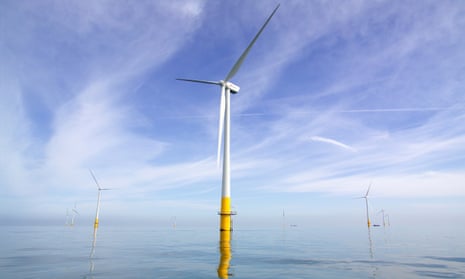Britain accounted for more than half of the new offshore wind power capacity built in Europe last year, as the sector broke installation records across the continent.
The windfarms out in the North Sea and other shallow European waters are getting bigger in every sense. Soon turbines will almost be as large as the Shard, Europe’s tallest building.
The average capacity of the 500-plus turbines connected to the grid was up by more than a fifth on the year before, with 17 windfarms on average a third more powerful.
Q&AWhat share of the UK’s power comes from offshore windfarms?
Show
Offshore windfarms in the UK supplied 3.95 terawatt hours of power from the start of July to the end of September, the latest period for which data is available. That was 5.3% of all electricity generation.
For 2016, the latest full year of data, the share was 4.8%. Expect that to grow significantly in 2018, as new windfarms are connected to the grid.
In total the UK installed 53% of the net 3.15GW of capacity installed across Europe, which beat the previous record of 2015, according to industry body WindEurope.
France deployed its first offshore turbine – a single, floating one – while the Norwegian oil firm Statoil established the world’s first floating windfarm in Scotland. The first windfarm designed to withstand icy conditions was built in Finland.
Giles Dickson, WindEurope’s chief executive described last year’s 25% increase in volume as “pretty spectacular”.
Costs continue to fall in the near future as manufacturers and windfarm developers deploy ever-bigger turbines, he said.
At present, developers are opting for 8MW-9MW turbines but by 2023 and 2024 that will have climbed to 13MW-15MW, the industry believes.
“And we’ll be beyond that in the next decade, there’s no reason to think we won’t,” said Dickson, adding that turbine manufacturers are not yet nearing physical limits on size.
It is forecast that 2018 will be another record-breaking year for new capacity, driven largely by delayed windfarms in UK waters.
At present, there is a cumulative capacity of 15.78GW of offshore wind, which is predicted to reach 25GW by 2020. Longer term, the UK is expected to retain its top spot by 2030, followed by Germany, the Netherlands, and France taking fourth spot from Denmark as it invests in floating turbines.
Offshore wind has been largely supported by government auctions of a guaranteed price of power to developers. In the UK they fell to record lows in the last year, although the sector will need such top-up contracts for years to come.

Separately, ministers were urged by 10 groups to reveal plans for supporting small-scale renewables, such as solar panels on household and business rooftops.
The current feed-in tariff scheme was cut heavily in 2016 by the UK government, and is due to end in 2019.
The government is exploring how to encourage small-scale, low carbon power but has yet to publish its plans. The uncertainty is hitting investor confidence, said groups representing the big six energy firms, landowners and the renewables industry.

Comments (…)
Sign in or create your Guardian account to join the discussion